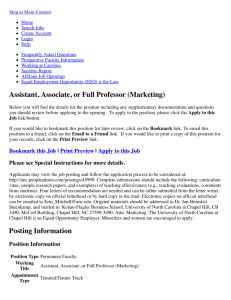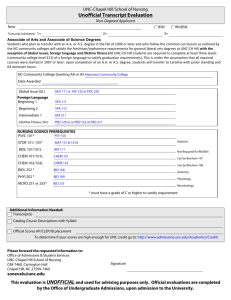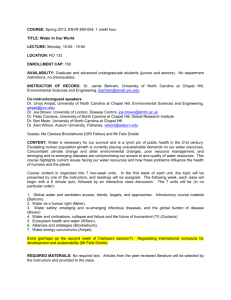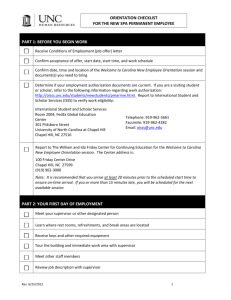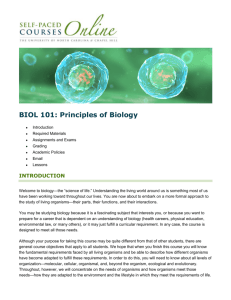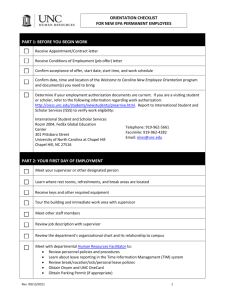Assessing Performance - Office of Institutional Research
advertisement
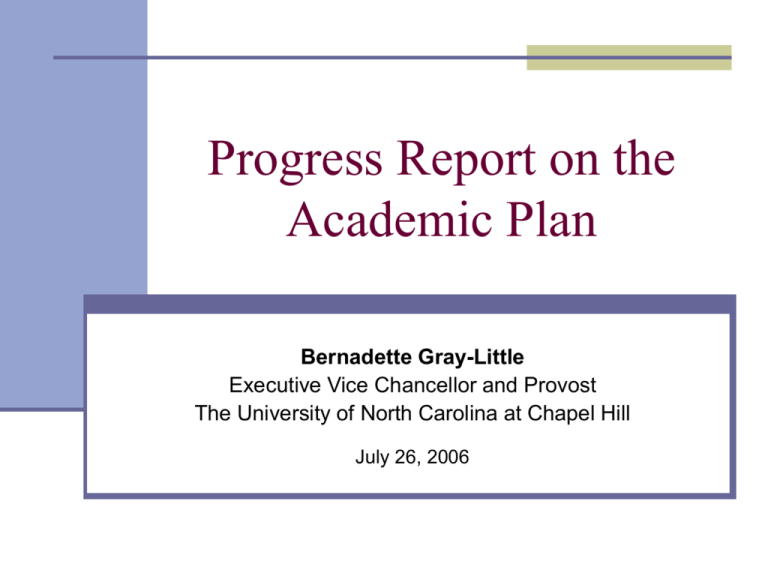
Progress Report on the Academic Plan Bernadette Gray-Little Executive Vice Chancellor and Provost The University of North Carolina at Chapel Hill July 26, 2006 Peer Institutions Used in Comparisons University of California – Berkeley University of California – Los Angeles University of Florida University of Illinois – Urbana-Champaign University of Michigan – Ann Arbor University of Pittsburgh – Main Campus University of Texas – Austin University of Virginia University of Washington – Seattle University of Wisconsin - Madison Priority A Provide the strongest possible academic experience for undergraduate, graduate, and professional students. Undergraduate Education Measures Course sections with fewer than 20 students 2002 UNC-Chapel Hill: 40% Peer Mean: 42% 2003 UNC-Chapel Hill: 51% Peer Mean: 42% 2004 UNC-Chapel Hill: 54% Peer Mean: 43% 2005 UNC-Chapel Hill: 50% Peer Mean: 42% Source: US News and World Report Best Colleges, 2004 - 2006 editions. 2005 data source: 2005-06 Common Data Set Undergraduate Education Measures First year retention rate remained steady at 95% for the previous three years Retention rate for 2004 cohort was 97% AAU mean is 89% Source: AAUDE Comparative Retention and Graduation Study, 2002-2005 Undergraduate Education Measures Four year graduation rates for Freshman entering in: 1998 UNC Chapel Hill: 67% Peer Mean: 50% 1999 UNC Chapel Hill: 71% Peer Mean: 53% 2000 UNC Chapel Hill: 65% Peer Mean: 56% 2001 UNC Chapel Hill: 71% Peer Mean: 56% Source: AAUDE Comparative Retention and Graduation Study, 2002-2005 Undergraduate Education Measures Six year graduation rates for Freshman entering in: 1996 UNC Chapel Hill: 80% Peer Mean: 78% 1997 UNC Chapel Hill: 83% Peer Mean: 79% 1998 UNC Chapel Hill: 81% Peer Mean: 80% 1999 UNC Chapel Hill: 84% Peer Mean: 80% Undergraduate Education Measures External rankings and evaluations of programs Kiplinger’s 2006 Top Deals in Higher Education ranked Carolina # 1 overall for the fifth year in a row. Carolina was ranked #1 for in state students, and # 3 for out of state students. US News 2006 ranked Carolina 1st among public campuses and 10th overall in "Great Schools, Great Prices," based on academic quality, net cost of attendance and average student debt. #1 in Forbes’ ranking of entrepreneurial universities The Center: Top American Research Universities: scored 9 out of 9 measures A "best value" among 81 schools chosen for "America's Best Value Colleges, 2006 Edition" by The Princeton Review/Random House for outstanding academics, relatively low costs, and generous financial aid packages. Sources: Kiplinger’s Personal Finance Magazine, June 2006; The Center publication, “The Top American Research Universities”, Nov 2004. http://thecenter.ufl.edu/research2003.pdf; The Princeton Review, America’s Best Value Colleges, 2006 Graduate Education Measures 2005 passing rates on professional exams Medical Boards: Step 1: 98%, Step 2: 97% Dental Boards State: 95%, National Boards Part 1: 96%, Part 2: 97% Bar Exam: UNC: 83%, Statewide: 81% Praxis II Exam for Education: UNC: 100%, Statewide: 97% National Council Licensure Examination for Registered Nurses (BSN programs): UNC: 94%, National: 87% Pharmacy Licensure Examination: UNC: 98%, National: 89% Sources: UNC-Chapel Hill School Of Medicine Curriculum Profile Reports and Liaison Committee on Medical Education Annual Medical School Questionnaires; UNC-Chapel Hill School of Dentistry; UNC General Administration; UNC-Chapel Hill School of Education; North Carolina Board of Nursing; UNC-Chapel Hill School of Pharmacy and the National Association of Boards of Pharmacy. Graduate Education Measures US News & World Report, Best Graduate Schools, 2006 Edition School of Public Health: 2 School of Nursing: 5 School of Pharmacy: 3 School of Medicine: 20 (# 2 in Primary Care) School of Information and Library Science: 1 Department of Sociology: 4 School of Social Work: 7 School of Government (Public Administration): 8 Department of History: 13 Department of Chemistry: 14 (#1 in Analytic Chemistry) Department of Political Science: 13 Department of Psychology: 22 Department of English: 19 Kenan Flagler Business School: 20 School of Law: 27 School of Education: 29 Graduate Education Measures Comparison of Average Teaching Assistant compensation with AAU peers Academic Year 2001-02 2002-03 2003-04 2004-05 2005-06 UNC-Chapel Hill $11,379 $11,944 $12,400 $12,762 $13,128 Public Peers $12,796 $12,941 $13,282 $13,723 $14,182 Minimum TA salary boosted to $7,000 per semester for fall 2006 Even with increase in minimum TA salary from $5,000 in 2002 to $7,000 in 2006, Carolina remains in the bottom quartile of its peers for TA stipends Source: AAU Data Exchange and UNC-Chapel Hill Payroll files Priority B Further integrate interdisciplinary research, education, and public service. Interdisciplinary Initiatives for 2006 Parr Center for Ethics Carolina Performing Arts Academic Integration Program School of Medicine promotion and tenure policy changes to reward interdisciplinary contributions to faculty productivity Translational Medicine Initiative, speeding development of new drugs and furthering collaboration with physicians and research faculty, boosted by $2.5 million funding from Legislature Priority C Improve faculty recruitment, retention, and development. Faculty Recruitment Number of Opportunity and Spousal/Partner Hires Per Year: 2002-03: 7 opportunity, 3 spousal offers 2003-04: 8 opportunity, 4 spousal offers 2004-05: 16 opportunity offers, 12 spousal offers 2005-06: 14 opportunity offers, 8 spousal offers Faculty Start-up allocations from Provost’s Office: $4,424,650 for 2002-2003 $6,372,258 for 2003-2004 $5,899,550 for 2004-2005 $7,274,000 for 2005-2006 Source: Office of the Executive Vice Chancellor and Provost Faculty Development 39 Junior Faculty Development Awards (increased funding from $5,000 to $7,500 per award; total funding increased from $215,000 in 2004-05 to $292,500 in 2005-06) 14 Senior Faculty Competitive Leave Awards ($892,769) Source: Office of the Executive Vice Chancellor and Provost Priority D Increase diversity among faculty, students, and staff. Minority Faculty Number and percent of total minority faculty: Year Tenured/Tenure Track Fixed Term All Faculty 2002 230 (12.5%) 148 (17.1%) 378 (14%) 2003 250 (13.7%) 162 (17.7%) 412 (15%) 2004 254 (13.9%) 189 (18.7%) 443 (15.6%) 2005 260 (14.3%) 205 (19.2%) 465 (16.1%) Source: UNC-Chapel Hill Fact Books Note: “Minority” includes all races except White/Caucasian. Minority Students Number and percent of student population: Year Undergraduate Graduate Professional All Students 2002 3,546 (22.2%) 2,143 (27.9%) 560 (23.5%) 6,249 (24%) 2003 3,928 (24.3%) 2,213 (28.2%) 583 (24.7%) 6,724 (25.5%) 2004 4,242 (25.7%) 2,369 (29.6%) 603 (25.7%) 7,213 (26.8%) 2005 4,433 (26.4%) 2,548 (31.2%) 600 (25.7%) 7,581 (27.8%) Source: UNC-Chapel Hill Fact Books; Note: “Minority” includes all races except White/Caucasian. 2006 Diversity Assessment Supplements the Academic Plan Six goals: Define and publicize Carolina’s commitment to diversity Ensure accountability Achieve critical mass of underrepresented populations in faculty, staff and students Make high quality diversity training available Create climate where respectful discussion flourishes Support research Implementation to begin this fall Priority E Enhance public engagement. Chancellor’s Task Force on Engagement Four subcommittees submitted initial reports in March: Education Health Economic Development Cross cutting issues Chancellor will issue report and recommendations in September Source: Carolina Center for Public Service Chancellor’s Carolina Connects Tour Since April of 2004 the Chancellor has made 65 visits to communities from Manteo and Shallotte in the East to Asheville and Cullowhee in the West and points in between. Stops have focused on the Carolina Covenant program, the Citizen-Soldier initiative and numerous research and public service projects. Tour highlight the ways in which the University’s faculty, staff and students serve the people of North Carolina. Public Service Scholars Program In 2006, forty students graduated from Carolina as Public Service Scholars They completed 19,653 hours of service, an average of 491 hours per graduate In three and a half years, participants have logged over 113,500 hours Program has grown from 78 to 742 students, with participants from 90 of North Carolina’s 100 counties and 34 other states and the District of Columbia Public Service Scholars Program Per semester growth in enrollment 800 700 600 500 400 300 200 100 0 Spring 2003 Fall 2003 Spring Fall 2004 2004 Spring Fall 2005 2005 Spring 2006 Graduate Education Advancement Board IMPACT Awards GEAB presented IMPACT awards to 13 projects and gave recognition to an additional 26. A faculty review committee selected the projects for their contributions to issues that face the state. The research projects were in the areas of economic development, health and human services, education, and the environment. Priority F Extend Carolina’s global presence, research, and teaching. Foreign Students and Scholars* Year Undergraduate Graduate Non-degree/ exchange All Students Scholars* 2002 178 971 125 1,274 1,017 2003 188 938 128 1,254 1,024 2004 222 968 141 1,331 1,047 2005 206 967 174 1,347 1,183 *Scholars are individuals on campus for primarily research purposes (e.g. research associates, post-docs, faculty) Source: UNC-Chapel Hill Office of International Student & Scholar Services International Affairs Initiatives 2005-06 China Initiative Created various China working groups the total roster for which come to over 120 faculty and staff MOU’s signed between various units at UNC-Chapel Hill and the Chinese Joint programs, workshops, conferences held with Chinese Government, Tsinghua University Globalization and the American South Global Health New Title VI Center for African Studies Source: Associate Provost for International Affairs Accomplished Our Three Major International Affairs Goals for 2004-05 Secured funds to complete the Global Education Center, largely through a $5 million pledge from FedEx Moved ahead on the undergraduate joint-degree program with the National University of Singapore. On our end, the program passed through all levels of the approval process at UNC-Chapel Hill, and now needs only the final approvals of GA and the Board of Governors. Retained our status as one of the top public research universities in terms of the proportion of undergraduates we send abroad; worked to rationalize and enhance the quality of the study abroad programs in which we are involved. Source: Associate Provost for International Affairs SACS Recognition Our International programs and initiatives received very strong endorsements from the site visit team that visited UNC-Chapel Hill in April 2006 as part of decennial reaffirmation of accreditation process by SACS (Southern Association of Colleges and Schools). International programs and initiatives are a key component of the institutional Quality Enhancement Plan (QEP) required for reaffirmation of accreditation. Progress Report on the Academic Plan Closing Questions and Comments
